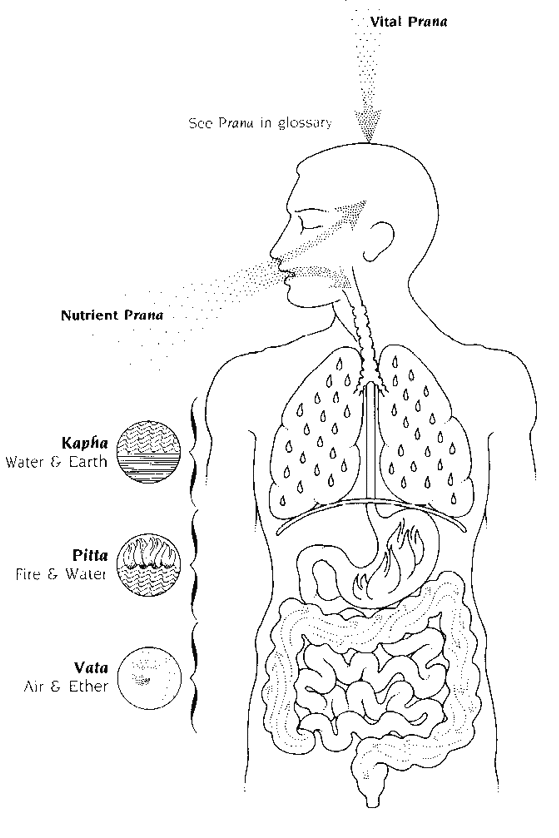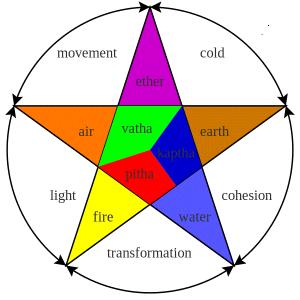by Ani Naqvi & Andrea Barra
Yoga practices such as Asana (positions), pranayama (breathing exercises) and meditation ideally should be chosen according to one’s individual Ayurvedic constitution (Prakruti).
This is because different practices have a variety of effects on the Body and Mind, which can either pacify or increase a particular dosha, thereby promoting a positive or negative effect on emotions, moods, body ailments etc.
Whilst some may feel energised and revitalised with a dynamic, vinyasa style yoga others may find the same practice increasing anxiety and creating body pains. Yoga as a stand-alone practice without taking Ayurvedic prakruti and vikruti into account can create imbalances rather than creating harmony if an incorrect practice is done.
Prakruti refer to the combination of dosha that we are born with, the natural constitution.
Vrikruti refer to the combination of dosha at the present moment.
Whilst most postures are suitable for all doshas there are some that are better than others, some which should be avoided and most importantly it’s the manner in which the posture is done that makes the biggest difference.
Vata
Vata predominant people have a tendency to become stiff due to weakness in their bones and joints so benefit from a gentle asana practice.
Their practice should be calming, slow, steady, grounding, strengthening and warming. This will counter balance vata’s tendency to become agitated, airy and nervous. Vata benefits from closing their eyes to help ground them to the earth and from postures such as supine, prone and seated postures. The sun salutation sequence and other vinyasa should be done slowly and consciously with full awareness of the breath. Many repetitions of sun salutations can aggravate Vata so a few to warm up slowly are sufficient. As the seat of vata resides in the lower abdomen, large intestine and pelvis, vata benefits greatly from asanas that cause the abdomen to become tight as well as asanas that strengthen the lower back. Paschimottanasana (Seated Forward bend), Child’s Pose & Dhanurasana (Bow Pose) are examples of asanas that are particularly good for vata. As vata tend to have weaker bones, great care should be taken whilst practicing Sarvangasana (Shoulder stand) and Halasana (Plough Pose) and other postures where pressure is placed on the joints. If they do practice these postures then padding should be placed underneath to protect the neck and the posture should not be maintained for a long time.
Vata benefit vastly from the practice of calming pranayamas such as Nadi Shodan, the alternate nostril breathing and brahmmari. The first of which helps to balance the ida and pingla energies and brahamari, which alleviates stress and assists in grounding Vata, which they find quite difficult.
At the end of the practice vata need a long shavasana (10 min. +) and a regular meditation practice after Shavanasa when they are at their most relaxed. Yoga Nidra and other meditation practices will help them to focus their mind on the present and will assist in calming their vata tendencies to always be thinking of many things at the same time. Omkar chanting and other mantra chanting is also highly beneficial for vata. As well as basti as a yoga cleansing for the large intestine.
Pitta
People with a Pitta constitution need a cooling, relaxing, surrendering and gentle practice. They should not push themselves and avoid being competitive and doing more showy asanas as a practice. They need to be careful not to increase their body temperature too much and need calming asanas to help curb their intense and assertive nature and tendencies to become angry or hot headed.
As the seat of pitta resides in the abdomen and small intestine, (the middle trunk of the body), the asanas that are most beneficial for pitta are those that place pressure on those areas. Pitta out of balance tends towards acidity and ulcers so these asanas directly affect the liver and spleen and helps regulate Agni (digestive fire).
Ustrasana (Camel Pose), Bhujangasana (Cobra Pose) and Dhanurasana (Bow Pose) are good abdominal stretch poses for pitta. These asanas can help in the treatment of ulcers and hepatitis. Headstands on the other hand increase heat in the body especially in the head and the eyes, which is one of the sites of Pitta and is therefore not recommended. If a pitta person really wants to practice headstand it should be done for a short amount of time.
Pitta can still do a strong practice but they need to compensate it with asanas or pranayama that cool them down such as the shitali, shitkari and left nostril breathing pranayamas. They also benefit from a cooling and relaxing Shavasana and Meditation practice. Omkar mantra chanting is good for Pitta also.
Kapha
People who have a Kapha constitution are prone to having a sluggish metabolism and can have a tendency towards a more cold, heavy, slow and relaxed nature thus benefiting from a practice, which is stimulating, moving, warming, strengthening and energizing. This helps them increase their metabolism and provides them with more vim and vigour.
As the seat of kapha resides in the chest, throat and nasal passages, (the upper part of the body) and takes the form of accumulated mucous, kapha benefits greatly from chest openers and back bends which help open the chest thus preventing congestive conditions like bronchitis, pneumonia as well as more constrictive conditions such as emphysema and asthma.
They are really the only ones who should choose a more dynamic form of yoga to increase their metabolism and inspire them to more activity. They benefit from strong practices with strong vinyasa. Surya Namaskar done in a dynamic way as a cardio vascular practice helps to increase the heat in the body and works very well for kapha people. It helps to open the chest and assists with alleviating depression and obesity, which are mostly kapha imbalances.
Bhujangasan (Cobra Pose), Ushtrasana (Camel Pose) and Chakrasan (Wheel Pose) or Ardha Chakrasan (Half Wheel Pose) (if Wheel can’t be performed) are good chest openers for kapha. As kapha has strong bones and joints they are able to handle strengthening postures and need flexibility and strength to counter their tendency to become stiff.
Most postures are good for kapha with the exception of postures that place a lot of pressure on the abdomen such as Dhanurasana (Bow Pose) which if held for a long time can put too much pressure on kapha’s weaker kidneys.
Kapha benefits from warming and energizing pranayama like kapalabhati, bastrika and right nostril breathing. Kapha also benefit from Agni sar and nouli techniques plus Gayatri mantras chanting as these all increase the heat in the body. Kapha doesn’t need a long shavasana but can benefit from meditation to help with their depressive tendencies.
These are the general considerations for the different doshic types. The particularities of the individual body structures and organic conditions are more important then the doshic type in asana practice.
Sources / Further Reading:
“Ayurveda: the science of self healing” – Dr. Vasant Led
“Yoga and Ayurveda” -Dr David Frawley
Sanatan Society website “Asanas & Doshas” – Peter Marchand
“Ayurveda and Asana” – Mark Halpern





